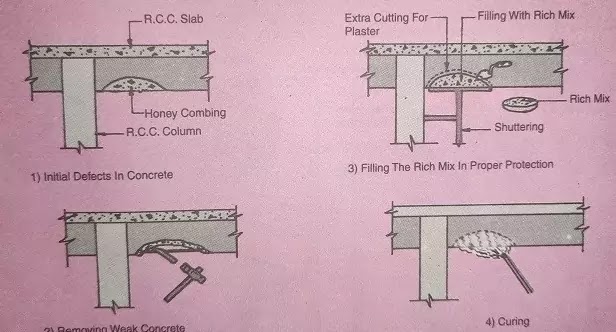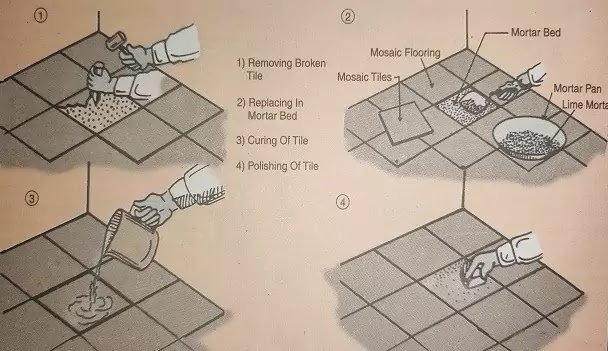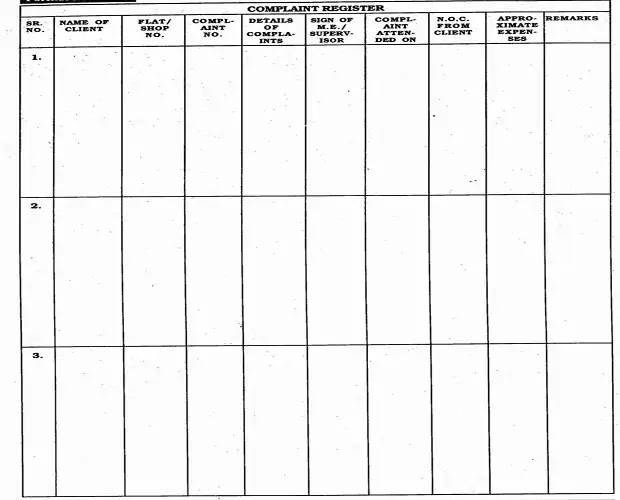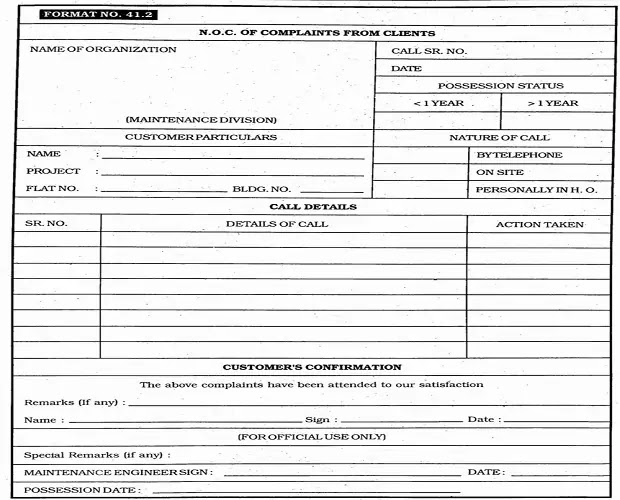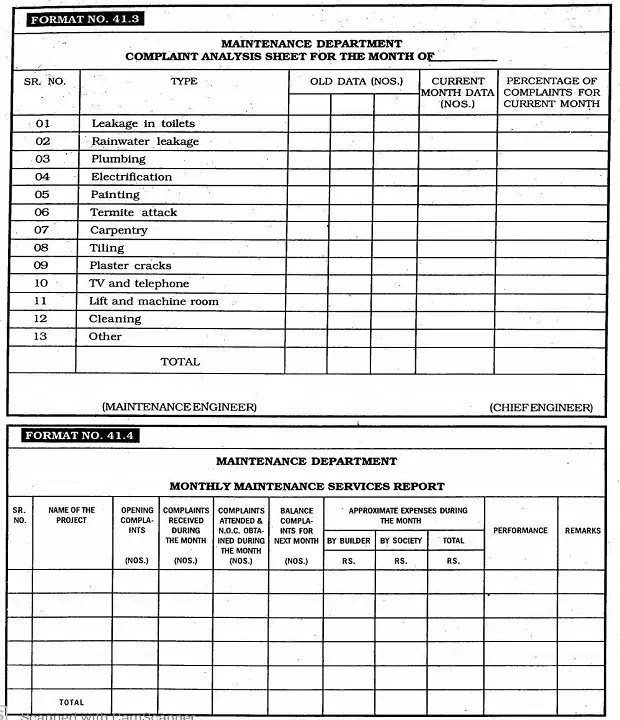1. REPAIRS IN R.C.C. WORKS FAILURE OF TEST CUBES
- Normally, six numbers of concrete cubes should be tested for strength. The location and date of casting should be marked on each cube.
- If it is observed that seven days’ strength is less, then the following precautions should be taken.
- Increase the de-shuttering period of the particular slab and wait for the results of twenty-eight days’ strength.
- Locate the position on the slab and test the strength with normal hammering. It should give a ringing sound for better strength concrete.
- If the slab gives a different sound, then break the particular portion and re-concrete after consulting the structural consultant.
- If the structural consultant is satisfied with the strength of concrete at site, even after the poor result of a particular cube, then the report should be sent to the Chief Engineer accordingly, for acceptance of the concrete quality.
2. FOR R.C.C. WORK, OUT OF PLUMB AND LINE
Rectify any defects through the demolition of the faulty work and re-concrete it. Necessary precautions should be taken as mentioned below
- Give proper bracing supports for the adjacent structure, before breaking the defective works.
- Bind extra steel, if necessary.
- Check all shuttering work for proper line and plumb.
- Use a proper mix for concrete.
- For minor cracks in adjacent areas, cement slurry grouting should be done.
- Observe curing for all repaired works.
- Execute all these works as per the structural consultant’s instructions.
3. MAJOR HONEYCOMBING AND VOIDS IN CONCRETE
- Remove all loose weak concrete with chisel and hammer.
- Do proper shuttering, if required.
- Re-concrete with a rich mix. For minor voids, 1:4 or 1:3 cement-sand-mortar should be filled In the voids.
- All cracks should be grouted with cement slurry.
- Sometimes It becomes necessary to make openings in a cast slab, e.g,, for creating access from the basement to the top floor, by breaking the R.C.C. slab or extending balcony portion porch, by increasing cantilever bracket length, etc. For such rectifications, the following precautions should be taken.
- Any change in R.C.C. work should be done after consulting the structural designer.
- Support and brace all adjacent work properly.
- Execute any repair work required for rectification immediately.
- Observe curing on all repaired works.
5. REPAIRS IN MASONRY WORK
IMPROPER JOINING WORK OF BALCONY PARAPET
- Remove all loose weak masonry work.
- Create proper voids in the adjacent wall for locking purposes.
- Take care to minimize damages to already completed masonry.
- Execute repairing work carefully. If required, the affected portion also.
- Observe during all repaired works.
6. IMPROPER FIXING OF HOLDFAST
- Loosen the improper holdfast without disturbing the adjacent work.
- Make 15em x 15cm void for holdfast fixing.
- Embed holdfast property in 1:2:4 concrete. Finish the concrete area with cement mortar, the surface to be roughened with wire, after finishing.
- Redo the joint filing of the adjacent disturbed masonry.
- Observe curing on all repaired works.
- The same procedure for all adjacent work should be followed, to rectify defective window fixing work.
- Observe supervision on repaired works.
7. REPAIRS IN PLASTERING WORK
- Remove all defective plaster finishing from the wall surface.
- Observe disturbance cracks developed on sidewalls.
- Re-do plastering with necessary precautions.
- Also, repair any cracks developed on the disturbed area.
- Observe curing for all repaired work.
8. REPAIRS IN WATERPROOFING
Repairs in water-proofing should be done by the approved agencies only.
- Avoid a plumbing agency for spouts, ghabadi work.
- External and internal ghabadi finishing, after fixing the rainwater pipe, should be done by the waterproofing contractor carefully with waterproofing chemicals.
- If the waterproofing agency has done excess waterproofing treatment on walls of W.C., get it rectified by the same agency, before fixing glazed tiles.
- Ensure the necessary precautions for the required water tightness.
- All repair works should be properly cured.
roof leakage repair under 100 rupees|leaking roof|
Broken mosaic tiles during polishing of the flooring should be repaired before further polishing, as specified below.
- Remove the broken tile piece, by breaking it from the center. Ensure that the adjacent tiles are not disturbed.
- Remove any such disturbing tiles.
- Remove the hardened cement by hammering.
- Prepare a rich cement slurry and refix the tile with a proper finish at the joints. Cure this work properly.
- If possible, use a polish machine or hand polish to bring repaired portion and adjacent polished tile in one level and line.
- Balance coats of polishing should be carried out on the entire area.
B BUILDING MAINTENANCE PROCEDURE – AFTER POSSESSION
Despite the precautions during the execution of the building maintenance procedure is required. A common man may not realize the exact problems in case of leakages, plumbing faults, etc. Only experienced and qualified persons can solve these problems.
Maintenance requirements are comparatively more during the first year of the building’s service. So, a full-fledged maintenance division is a must in every organization, for the maintenance of the completed project to the complete satisfaction of the client.
- Intermediate checking of the execution of work, to minimize the complaints in the future.
- Guideline at the time of finalization of the working drawings, maintenance problems.
- Final checking of the units before possession.
- Managing the formalities for handing over the units to the clients.
- Rendering the ‘after-sales services’ regarding maintenance.
- Trying to minimize maintenance.
- Detail survey of complaints and study for improvements in execution.
- Getting feedback from clients, in terms of their reactions and suggestions.
- Market survey for chemicals and other materials required for maintenance of the building.
- Attending seminars to upgrade information about maintenance services.
- Feedback via reports to the management.
2. EXTRA AMENITIES
4. MAINTENANCE OF MACHINERIES
5. OFFICE MAINTENANCE
Overall maintenance of the office building and other properties of the organization.
- The client should submit the complaint to the maintenance department, either on the telephone or personally.
- The client should obtain the serial number for the complaint.
- A maintenance engineer should depute his staff for sorting out the complaint.
- Maintenance staff should visit the place, with the required tools and materials, as per the nature of the work involved in the complaint.
- If the complaint is serious or complicated, the maintenance engineer should personally visit the place and after inspection, instruct his staff of the necessary repairs.
- After sorting out the complaint, the maintenance staff member should take the signature from the client or his representative for completion of TV the work.
- The client will sign the printed N.O.C. form. if satisfied with the work.
- One maintenance supervisor should be deputed on the job.
- The complaint register should be maintained by this supervisor in the society office.
- Clients society members should enter their complaints in the said register.
- The maintenance supervisor should issue a complaint No. for each and every complaint.
- Complaints should be sorted out within two days. In case of delay due to whatever reason, the maintenance supervisor should inform the client accordingly.
- After satisfactory completion of the job, the maintenance supervisor should take the N.O.C. from the client on the standard N.O.C. format.
- If a client approaches the maintenance department directly at the Head Office, the complaint no. should be issued to him from the head office. This no. should then be communicated to the maintenance supervisor on site.
8. DAY TO DAY MAINTENANCE OF THE SOCIETY
- The day to day maintenance includes
- Cleaning the entire area of the project.
- Security services.
- Attending to the complaints (by the concerned staff like plumber, electrician, carpenter, mason, helpers, etc.).
- Maintenance of swimming pool (if any).
- Garden maintenance.
- Common electricity such as parking garden lights, staircase lights, etc.
- Lift maintenance.
- Water charges.
- Electricity charges.
- All these activities should be managed by the society management committee with the utilization of society funds.
- Maintenance the engineer should conduct periodical meetings with the society members, to discuss the problems of maintenance. After handing over, the society chairman should call meetings with all members to solve any problems, ensuring coordination among the members.
REPORTING SYSTEMS OF THE BUILDING MAINTENANCE DEPARTMENT
1. COMPLAINTS ANALYSIS REPORT
2. MONTHLY REPORTS ABOUT MAINTENANCE
The advantages of this monthly maintenance report are as follows
- Directors’ top officials can judge the performance department at a glance.
- Site-wise performance can also be judged for maintenance every month.
- Facilitates finding out the percentage increase of complaints, due to the change of season.
- The judgment of the maximum and a minimum number of complaints on various projects can be judged.
- Project-wise expenses can be compared and reasons for high expenditure, along with affected zones, can be verified.
- The effect of the new construction methods systems employed can be reviewed by referring to the data on old and new projects.
Also, Read This.

